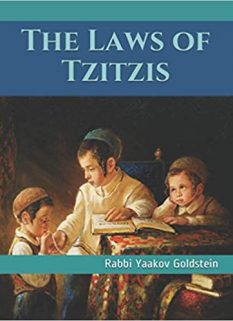*The article below is an excerpt from the above Sefer
*As an Amazon Associate I earn from qualifying purchases.
Chapter 42: How fear of G-d is easily attainable
- The natural fear of G-d contained in every Jew, as elaborated on in the previous chapter, sheds light onto the following cryptic Talmudic statement:
- Fearing G-d is easy: The Talmud[1] brings the verse “Viata Yisrael, Mah Hashem Elokecha Shoel Meimcha Ki Im Leyirah Es Hashem Elokecha/And now, Israel, what does the L‑rd your G‑d require of you? Only that you fear the L‑rd your G‑d.” The Gemara asks on this verse “Is fearing G-d such a small feat etc.?” and the Talmud answers “Yes, regarding Moshe it is a small feat etc.”
- The question: This Talmudic teaching seems puzzling and incomprehensible, as the verse states that the entire nation is demanded to fear G-d and not just Moshe, so how is the fact that Moshe can easily attain this fear answer for how this fear is no big deal for the rest of the Jewish people? The explanation is as follows:
- Every Jew has a Moshe in him: The soul of every single Jew contains an aspect of Moshe Rabbeinu, as he is from the seven shepherds who draw down a flow of vitality [i.e. love and fear of G-d[2]] and[3] G-dliness [i.e. nullification and Mesirus Nefesh[4]] to the general souls of Israel.
- The function of a shepherd of Israel: It is for this reason that the seven leaders are called shepherds, as they provide the Jewish people with spiritual sustenance.
- Moshe is the leading shepherd of Israel: Now, Moshe Rabbeinu is the leading shepherd who contains aspects of all of them and is referred to as the Raya Mehemna.
- Moshe draws down Daas to the souls of Israel each to their level: This is because he is responsible for drawing down the level of Daas/knowledge to the general souls of Israel. The function of Daas is to have a cognitive grasp of G-d. Each and every soul contains a unique ability to intellectually grasp G-d in accordance to its level of comprehension, which is based on its soul root above, and its form of nurture from the root of the soul of Moshe Rabbeinu, which is rooted in the supernal Daas of the ten Sefiros of Atzilus, which in turn is united with Hashem, as He and His Daas are one.
- Aside from the above ray from the soul of Moshe which is found within the soul of every Jew, there also exists a much greater and powerful revelation from the soul of Moshe in every generation, within the leaders of that generation.
- A spark of Moshe: In each and every generation sparks from the soul of Moshe descend below and become invested in the body and soul of the sages and leaders of that generation.
- To teach the greatness of G-d to the masses: The purpose of this descent of sparks from Moshe into the leaders of the generation is for these individuals to teach Daas to the nation and help them know the greatness of G-d.
- Serving G-d with one’s heart: This knowledge received from leaders of the generation will in turn then be used by the masses to serve G-d with a full heart and soul, as service of the heart is in accordance to one’s knowledge, as the verse states “know the G-d of your father and serve Him with a complete heart and a desiring soul.”
- No more teaching in the future era: Regarding the future era, the verse states that no man will need to teach his friend the knowledge of G-d as everybody will know Me on their own.
- Purpose of knowledge is to experience it emotionally: The main purpose and function of having knowledge in the greatness of G-d is not just the knowledge itself, for one to garner knowledge of the facts of the greatness of G-d from books and teachers. Rather, the main purpose of knowledge is for one to deepen his mind’s concentration on the greatness of G-d to the point that one solidifies his thoughts with thoughts of G-d, with a strong and powerful [energy that comes from his] heart and mind. This itself is done to the point that one’s thought becomes tied and connected with G-d with an unbreakable knot, similar to one who becomes entranced with a physical item which he sees with his physical eyes and contemplates it in depth. This concept is well known that the term Daas means connection, as it states in the verse that Adam knew his wife Eve.
___________________________________________
[1] Brachos 33b
[2] Lessons in Tanya, edited by the Rebbe
[3] It is stated that the Alter Rebbe spent several weeks pondering whether to write this and or to simply write vitality G-dliness.
[4] Lessons in Tanya, edited by the Rebbe
Related Articles
Daily Tanya Thursday 14th Tamuz Igeres Hateshuvah Chapter 4 Part 2: The difference between the soul and angels, speech and breath
Post Views: 39 1. The Divine Origin of the Soul The Jewish soul is described as a “portion of the Divine,” referencing the verse “For the Lord’s portion is His people.” The soul’s origin is compared to the act of God “breathing” life into Adam, signifying an intimate and inner
Daily Tanya Wednesday 13th Tamuz Igeres Hateshuvah Chapter 4 Part 1: Teshuvah Ilah and Tatah
Post Views: 77 Chapter 4 1. Purpose of Repentance and Its Levels Repentance (teshuvah) is essential for spiritual atonement and cleansing of the soul before the Divine. After proper repentance, sacrificial offerings serve as a gift, as described in the Talmud. 2. Understanding True Repentance The main aspect of repentance
Daily Tanya Tuesday 12th Tamuz Igeres Hateshuvah Chapter 3 Part 3: Redeeming Fasts with Charity
Post Views: 116 1. Fasting in our times for rectification of sin: Fasting the full set of fasts for severe sins: One is to fast at least lease one time in his life the number of fasts required for the severe sins that carry a death penalty, such as for
Daily Tanya Monday 11th Tamuz Igeres Hateshuvah Chapter 3 Part 2: Who Should Fast?
Post Views: 135 11th Tamuz 1. Who Should Fast Frequent fasting is appropriate only for those who are healthy and strong, much like in earlier generations. Those whose health may be harmed by numerous fasts should avoid them, even for severe sins. 2. Limitations on Fasting Even in past generations,
Daily Tanya Thursday 7th Tamuz Igeres Hateshuvah Chapter 1 Part 1: The types of sins and their atonements
Post Views: 214 Chapter 1: 7th Tamuz 1. Types of Atonement There are three types of atonement, each corresponding to a category of transgression. Repentance (teshuvah) is required in all cases. 2. Atonement for Positive Commandments If one fails to fulfill a positive commandment and repents, forgiveness is immediate. However,
Daily Tanya Wednesday 6th Tamuz Shaar Hayichud Viemuna Chapter 12 Part 2: The 22 letters of the Hebrew alphabet
Post Views: 223 1. Reflective Nature of Divine Light Just as moonlight is a reflection of sunlight, the substituted letters are a reflection of the divine energy that sustains creation. 2. The Letters as Channels of Life-Force The letters of the divine utterances are channels for the life-force, light, and


 Donate
Donate
Leave A Comment?
You must be logged in to post a comment.